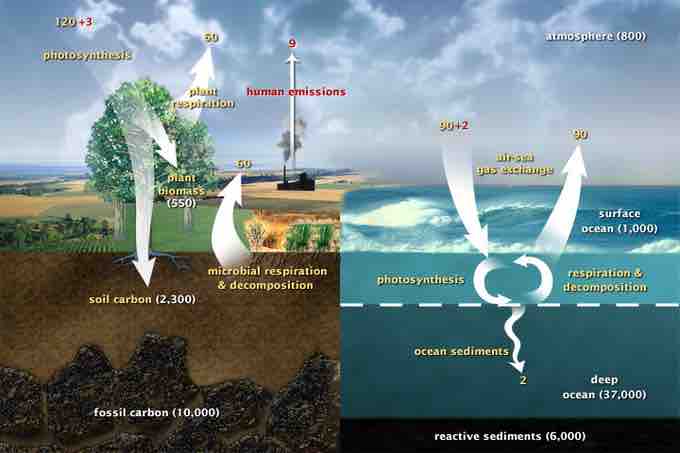The carbon cycle describes the flow of carbon between the biosphere, the geosphere, and the atmosphere, and is essential to maintaining life on earth.

The Carbon Cycle
The carbon cycle describes the flow of carbon between the atmosphere, the biosphere, and the geosphere.
Atmospheric Carbon Dioxide: Carbon in the earth's atmosphere exists in two main forms: carbon dioxide and methane. Carbon dioxide leaves the atmosphere through photosynthesis, thus entering the terrestrial and marine biospheres. Carbon dioxide also dissolves directly from the atmosphere into bodies of water (oceans, lakes, etc.), as well as dissolving in precipitation as raindrops fall through the atmosphere. When dissolved in water, carbon dioxide reacts with water molecules and forms carbonic acid, which contributes to ocean acidity. Human activity over the past two centuries has significantly increased the amount of carbon in the atmosphere, mainly in the form of carbon dioxide, both by modifying ecosystems' ability to extract carbon dioxide from the atmosphere and by emitting it directly, e.g. by burning fossil fuels and manufacturing concrete.
Terrestrial Biosphere: The terrestrial biosphere includes the organic carbon in all land-living organisms, both alive and dead, as well as carbon stored in soils. Although people often imagine plants as the most important part of the terrestrial carbon cycle, microorganisms such as single celled algae and chemoautotrophic bacteria are also important in converting atmospheric CO2 into terrestrial carbon. Carbon is incorporated into living things as part of organic molecules, either through photosynthesis or by animals that consume plants and algae. Some of the carbon in living things is released through respiration, while the rest remains in the tissue. Once organisms die, bacteria break down their tissues, releasing CO2 back into the atmosphere or into the soil.
Marine Biosphere: The carbon cycle in the marine biosphere is very similar to that in the terrestrial ecosystem. CO2 dissolves in the water and algae, plants and bacteria convert it into organic carbon. Carbon may transfer between organisms (from producers to consumers). Their tissues are ultimately broken down by bacteria and CO2 is released back into the ocean or atmosphere.
Geologic Carbon: The earth's crust also contains carbon. Much of the earth's carbon is stored in the mantle, and has been there since the earth formed. Much of the carbon on the earth's lithosphere (about 80%) is stored in limestone, which was formed from the calcium carbonate from the shells of marine animals. The rest of the carbon on the earth's surface is stored in Kerogens, which were formed through the sedimentation and burial of terrestrial organisms under high heat and pressure.